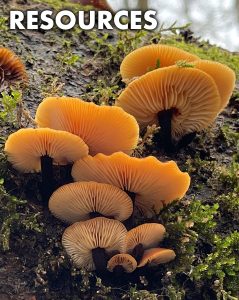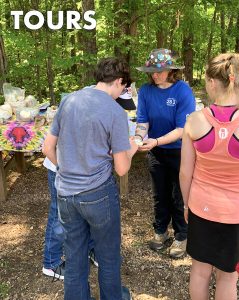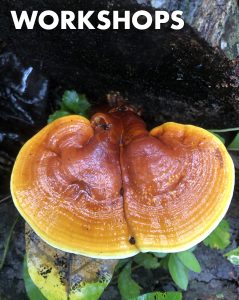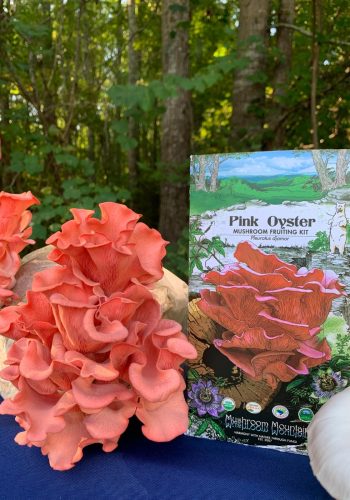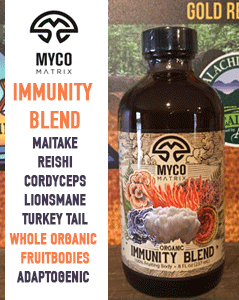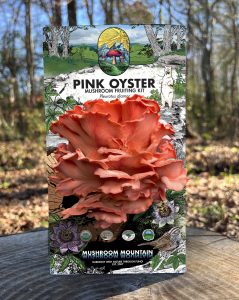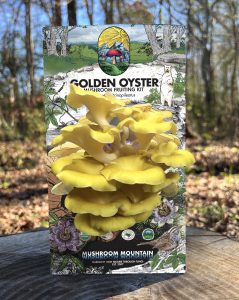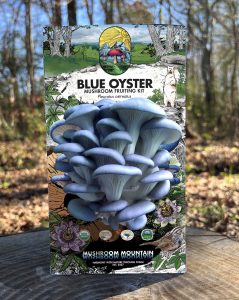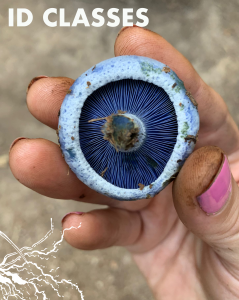Growing Mushrooms: Getting Started
I’ve never grown mushrooms before, what is the easiest way to start?
First, it is important to pick a species that is easy to grow. There are several species that are recommended for beginners based on their simplicity of growing method, ease of procuring source materials, and high rate of success.
Mushrooms fruit when they run out of space to colonize, so when they take over a log, mulch pile, bag of pasteurized wheat straw, or compost bed they are capable of fruiting. Check out our Growing Resources page for books, PDFs, and videos that will walk you through the basics of cultivation.
Easiest Outdoor Production?
Outdoors on Logs – Shiitake
 Shiitake mushrooms grown on logs outdoors are one of the easiest mushrooms for beginners to learn the cycles of mushroom production. Although oyster mushrooms may fruit easiest, they are insect prone, so Shiitakes are the one to start with. All log grown mushrooms are grown on fresh cut logs, so you will need to cut some fresh hardwood logs, preferably oak (check tree chart for alternatives), that is less than a month old cut from living healthy trees, 6-10” diameter logs are best. Logs are drilled with holes spaced out 4-5” around the entire bark-covered surface and filled with either plug or sawdust spawn. Sawdust spawn can inoculate up to 100 linear feet of wood and plug spawn can inoculate up to 10 linear feet of wood. The spawn is inserted, plug spawn is tapped in flush with a hammer and the sawdust is injected (with a plunger or stuffed in manually). Wax is melted in a jar sitting in hot water and brushed on with a small brush to cover the holes after the spawn is inserted. After all holes are spawned and waxed you are done spawning! Water logs occasionally, every week if it doesn’t rain, and after 8-10 months the mushrooms should have colonized and begin to fruit.
Shiitake mushrooms grown on logs outdoors are one of the easiest mushrooms for beginners to learn the cycles of mushroom production. Although oyster mushrooms may fruit easiest, they are insect prone, so Shiitakes are the one to start with. All log grown mushrooms are grown on fresh cut logs, so you will need to cut some fresh hardwood logs, preferably oak (check tree chart for alternatives), that is less than a month old cut from living healthy trees, 6-10” diameter logs are best. Logs are drilled with holes spaced out 4-5” around the entire bark-covered surface and filled with either plug or sawdust spawn. Sawdust spawn can inoculate up to 100 linear feet of wood and plug spawn can inoculate up to 10 linear feet of wood. The spawn is inserted, plug spawn is tapped in flush with a hammer and the sawdust is injected (with a plunger or stuffed in manually). Wax is melted in a jar sitting in hot water and brushed on with a small brush to cover the holes after the spawn is inserted. After all holes are spawned and waxed you are done spawning! Water logs occasionally, every week if it doesn’t rain, and after 8-10 months the mushrooms should have colonized and begin to fruit.
Shiitake comes in three strain types: Cold (33-50°F), Wide Range (50-75°F), and Warm/Hot (75-100°F)
Spawn all of the strain types at the same time. They will fruit when the temperature window comes around AFTER the initial 8-10 months colonization has completed. Each strain fruits twice a year, and you may soak 10% of each strain types every week to optimize your weekly harvest and repeat after the first cycle. Once the logs have fruited twice in a season let them rest, tarping them to dry, and initiating soaking again when the next season comes back around.
Soaking – To soak logs submerge them in water (well or city), for 12-24 hours but NO MORE– it will drown them.
Fruiting – After soaking, lean logs up against trees or cross-stack them in a log cabin pattern and the mushrooms should emerge in a few days. Make sure to keep these logs watered twice a day!
Picking – When shiitake caps flatten they are mature and can be twisted off and harvested.
Log Resting – After harvesting, the logs can rest for 8-10 weeks, should be tarped to dry, and can be re-soaked for a second time each year to produce another flush, after that they can be tarped until the following season. Shiitake logs can go dry for up to a year with no water and still live, so only water them when you want them to fruit!
Outdoors on Wood Chips – King Stropharia (Stropharia rugoso-annulata)
 King Stropharia, also known as Garden Giant and Wine Cap, is a hardwood chip loving mushroom that naturalizes easily in landscape mulch and gardens. It will not grow on conifer, so you will need fresh mushroom wood chips (from healthy trees and cut within a few weeks).
King Stropharia, also known as Garden Giant and Wine Cap, is a hardwood chip loving mushroom that naturalizes easily in landscape mulch and gardens. It will not grow on conifer, so you will need fresh mushroom wood chips (from healthy trees and cut within a few weeks).
You will need SAWDUST SPAWN for King Stropharia, and it’s as easy as mixing in the crumbled spawn into fresh wood chips (it helps to wet the chips first), and spread the spawn and chips into the landscape, between rows of vegetables, or top dress tree rings with the mixture to a depth of 3-8”.
King Stropharia fruit in the spring and fall, so if you spawn your chips in the spring they will fruit in the fall.
Outdoors on Manure Compost – Almond Portabella (Agaricus subrufescens/A.blazei)
Almond Portabellas are the cousins of the common white button and the crimini/portabella complex. Interestingly they are a tropical cousin that prefer to fruit at 75-90F, love composted livestock manure, making them a perfect candidate as a garden additive to intercrop mushrooms into vegetable beds or row crops.
You will need SAWDUST SPAWN that can be crumbled and mixed into the manure, which can then be turned into the soil or made into a bed all by itself.
Easiest Indoor Production?
Oyster Mushrooms
Oyster mushrooms can grow on a variety of wastes, including spent coffee grounds, recycled paper, cardboard, and even cotton clothing.
You will need SAWDUST SPAWN for oyster mushrooms on bulk media. The easiest way to start is by collecting spent coffee grounds (daily in your kitchen or ask a local coffee shop to save them). Make sure they are fresh and collected daily using your own container, coffee grounds can get colonized by a competitor green mold easy.
Container – Use a gallon screw top container or a 5 gallon bucket with a lid. Add your coffee and filter daily for personal use, sprinkling sawdust spawn into the container sparingly, like you are salting it. If you have a large amount from a coffee shop dump the coffee into a large clean tub and mix 2 cups of sawdust spawn for every 5 gallons of coffee waste into the media. After mixing, dump the coffee back into the bucket to colonize. Fill bucket but leave about 2” of space or so for the developing baby mushrooms.
Spawn run – Watch your bucket daily, it should start to turn white as it begins to colonize, finally taking over the entire volume of coffee. Keep lid cracked very slightly so it can breathe, but not dry out. If it looks dry, water it to moisten. Once the mass is solid and white, it will think about fruiting. Baby mushrooms will form after a few weeks and you can mist them with clean water and make sure to open the lid slightly more every day to accommodate the growth, since they can be large. Harvest when they have stopped growing, return lid to its cracked position for two weeks, then pour two cups of water into the bucket to rehydrate the media and repeat the steps of fruiting. It will fruit 2-3 times, maybe more!

